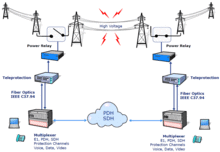C37.94
IEEE C37.94 , full title IEEE Standard for N Times 64 Kilobit Per Second Optical Fiber Interfaces Between Teleprotection and Multiplexer Equipment, is an IEEE standard, published in 2002, that defines the rules to interconnect tele-protection and multiplexer devices of power utility companies. The standard defines a data frame format for optical interconnection, and references standards for the physical connector for multi-mode optical fiber. Furthermore, it defines behavior of connected equipment on failure of the link, and the timing and optical signal characteristics.

Overview
Power utility companies protect high voltage lines by monitoring them constantly. This supervision requires the transmission of information between the power substations in order to ensure correct operation while controlling every alarm and failure. Legacy telecom networks were interconnected with metallic wires, but the substation environment is characterized by a high level of electromagnetic fields that may disturb copper wires.
The use of optical links at the physical layer, instead of the traditional metallic cables, as described in the IEEE C37.94 standard solves these issues.
Protection of high voltage power lines
Authorities use a tele-protection scheme to enable substations to communicate with one another to selectively isolate faults on high voltage lines, transformers, reactors and other important elements of the electrical plants. This functionality requires the continuous exchange of critical data in order to assure correct operation. In order to warranty the operation the telecom network should always be in perfect conditions in terms of availability, performance, quality and delays.
Initially these networks were made of metallic conductive media, however the vulnerability of the 56–64 kbit/s channels to electromagnetic interference, signal ground loops, and ground potential rise made them too unreliable for the power industry. Strong electromagnetic fields caused by the high voltages and currents in power lines occur regularly in electric substations.
Moreover, during fault conditions electromagnetic perturbations may rise significantly and disturb those communications channels based on copper wires. The reliability of the communications link interconnecting the protection relays is critical and therefore must be resistant to effects encountered in high voltage areas, such as high frequency induction and ground potential rise.
Optical media
Consequently, the power industry moved to optical fibers to interconnect the different items installed in substations. Fiber optics need not be grounded and are immune to the interferences caused by electrical noise, eliminating many of the errors commonly seen with electrical connections. The use of fully optical links from power relays to multiplexers as described by IEEE C37.94 became standard.
A more sophisticated architecture for the protection scheme emphasizes the notion of fault tolerant networks. Instead of using a direct relay connection and dedicated fibers, redundant connections make the protection process more reliable by increasing the availability of critical data interchanges.
The IEEE C37.94 standard
Teleprotection systems must isolate faults very quickly to prevent damage to the network and power outages. The IEEE committee defined C37.94 as a programmable n x 64 kbit/s (n=1...12) multimode optical fiber interface to provide transparent communications between teleprotection relays and multiplexers for distances of up to 2 km. To reach longer distances, the power industry later adopted a single mode optical fiber interface as well.
The standard defines the protection and communications equipment inside a substation using optical fibers, the method for clock recovery, the jitter tolerances allowed in the signals, the physical connection method, and the actions the protection equipment must follow when any kind of network anomalies and faults occur. C37.94 was already implemented by many protection relay manufacturers such as ABB, SEL, RFL, and RAD. Teleprotection equipment once offered a choice of transmission interfaces, such as the IEEE C37.94 compliant optical fiber interface for transmission over fiber pairs, and G.703, 64kbit/s co-directional and E1 interfaces.
Installation and maintenance
Field engineers may use testers to turn up new C37.94 deployments and troubleshoot teleprotection relays and multiplexers.[1] These testers should have features such as bit error rate testing (BERT), events monitoring, one-way-delay measurements, round trip delays and optical power measurement to facilitate engineers to install and maintain any protection system to automatically and to prevent outages in a power substations.[2]